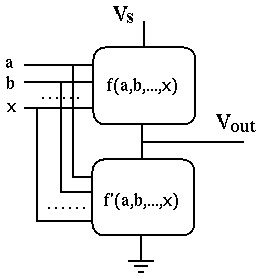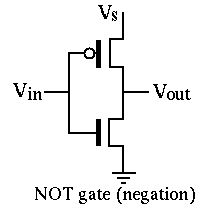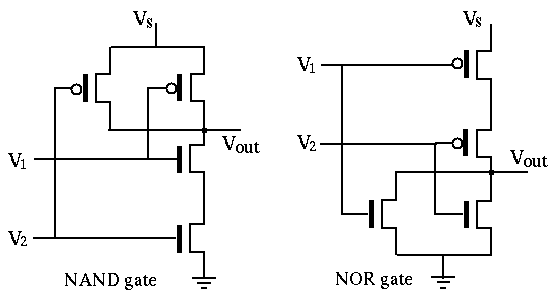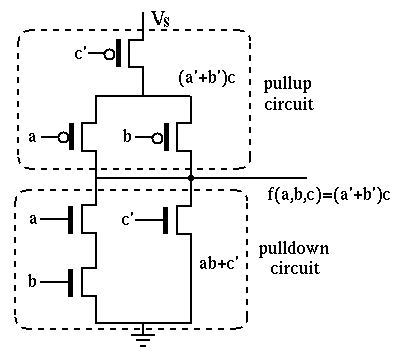The Logic family
is composed of different types of digital logic circuits:
Both the p-channel MOSFET (pMOS) and n-channel MOSFET (nMOS) can be
treated as a switch between its drain  and source
and source  controlled by
the voltage
controlled by
the voltage  between gate
between gate  and source
and source  . When
. When
 (e.g.,
(e.g.,
 ) for nMOS and
) for nMOS and
 (e.g.,
(e.g.,
 )
for pMOS, the circuit is a short-circuit because of the low resistance between
)
for pMOS, the circuit is a short-circuit because of the low resistance between
 and
and  ; otherwise, the circuit is an open-circuit due to the large
resistance between
; otherwise, the circuit is an open-circuit due to the large
resistance between  and
and  . A circuit composed of both types of MOSFET
transistors is called a complementary MOS or CMOS circuit, which
is widely used in digital systems.
. A circuit composed of both types of MOSFET
transistors is called a complementary MOS or CMOS circuit, which
is widely used in digital systems.
- Logic AND can be implemented by a series combination of two MOS
transistors, which conducts electricity if both are turned on and
conducting.
- Logic OR can be implemented by a parallel combination of two MOS
transistors, which conduct electricity if either of them is turned on
and conducting.
Due to such logic properties of the series and parallel connections of the
MOS transistors, various logic circuits can be constructed to realize any
arbitrary logic function
 by two complementary networks
of MOS transistors:
by two complementary networks
of MOS transistors:
- The pull-up network composed of pMOS transistors connected to the
positive voltage source
 so that the circuit will conduct.
so that the circuit will conduct.
- The pull-down network composed of nMOS transistors connected to
ground, so that the circuit will conduct.
These two pull-up and pull-down networks will turn on and off alternatively,
depending on the input variables of the logic function. If the pull-up
circuit representing the function
 is conduting and the
pull-down circuit representing the negation of the function
is conduting and the
pull-down circuit representing the negation of the function
 is cut-off, the voltage at output is pulled up to a high voltage (logical 1)
indicatng the function is true; when the pull-up circuit is cut-off and the
pull-down circuit is conducting, the voltage at output is pulled down to a
low voltage (logical 0) indicating the function is false.
is cut-off, the voltage at output is pulled up to a high voltage (logical 1)
indicatng the function is true; when the pull-up circuit is cut-off and the
pull-down circuit is conducting, the voltage at output is pulled down to a
low voltage (logical 0) indicating the function is false.

The specific circuits of the pull-up and pull-down networks are based on
De Morgan's Law which states: the negation (complement)  of a logic
function
of a logic
function  can be found by negating the logical operations (turn AND to
R and OR to AND) as well as the variables in a function. For example,
given a logic function
can be found by negating the logical operations (turn AND to
R and OR to AND) as well as the variables in a function. For example,
given a logic function
 , we can find its negation by
De Morgan's law:
, we can find its negation by
De Morgan's law:
![$\displaystyle f'(a,b,c)=[(a'+b')c]'=(a'+b')'+c'=ab+c'$](img764.svg) |
(183) |
Here are the CMOS implementations of some simple logic functions:
- Negation
The NOT gate is implemented by a pull-up circuit composed of only a pMOS
transistor and its complementary pull-down circuit composed of only a nMOS
transistor:

- Logic NAND:
The pull-up function is
 , the pull-down
function is
, the pull-down
function is
 .
.
- Logic NOR:
The pull-up function
 , the pull-down
function is
, the pull-down
function is
 .
.
 |
(184) |

- A random logical function
 :
:
The pull-up network implements the given function  while the pull-down
network implements its negation
while the pull-down
network implements its negation
 :
:















 so that the circuit will conduct.
so that the circuit will conduct.






![$\displaystyle f'(a,b,c)=[(a'+b')c]'=(a'+b')'+c'=ab+c'$](img764.svg)







 :
:


